
Dmitri Alperovitch@DAlperovitch
May 31
52 tweets
Fascinating interview with a private drone designer for the RU military. His knowledge of UKR & Western drones is limited and should be taken with some skepticism but he still presents a quite candid picture into the current state of unmanned warfare: youtube.com/watch?v=RmfNUM
youtube.com/watch?v=RmfNUM
 youtube.com/watch?v=RmfNUM
youtube.com/watch?v=RmfNUMRussian military was very slow to adapt to drone warfare even though Ukrainian forces have been experimenting with drones on a limited basis in the Donbas well before 2022. Russians dismissed it at the time as mere expensive toys
FPV tactics:
Humvees can be destroyed with a single FPV hit. Russians have learned to hit M1 Abrams tanks in the rear turret compartment that stores ammunition to have it go up in flames consistently. Hitting it in the turbine also disables it completely
Western drones:
He has a very negative view of Western drones, especially Switchblades. Switchblade 300 won’t even kill an infantryman with armor. Switchblade 600 is more capable but extremely expensive for what it offers
Boeing ScanEagle looks like ‘it was built in a high school workshop - everything held together with zipties and cheap Chinese glue’ (Ed: He doesn’t talk about Anduril, Helsing, etc drones that have earned some begrudging respect from the Russians lately)
Drone industrial complex:
Ukrainian drone designers innovate faster because their private developers work directly with military units and are able to adapt rapidly to the changing environment. Prototypes get sent to the front for experimentations.
In Russia, things move forward ‘not because the system helps, but in spite of it.’ Russian military is not well setup to work with private defense companies. However, the situation is now improving
Chinese components:
All Russian and Ukrainian drones are built with the same Chinese electronic components. But the real value is not in the components but how they are being put together
Chinese weapons:
Ironically, he believes that the Chinese developed weapons aren’t any good. They are built like ‘toys’ - not rugged and built without combat experience and knowledge
"Military hardware has to survive being tossed out of a trunk in the mud, sitting in the rain for a week, being covered in dirt and still work perfectly. Chinese gear just doesn’t hold up like that"
However, the quality of Chinese electronic components is not far off from Western ones. A bit worse but not critically so, while 20-100x cheaper. No sanctions enforcement means that thousands of microcontrollers from China can be bought easily by the Russians for their drones
Chinese exports:
Payments to Chinese sellers cannot be made with Russian bank cards anymore. A lot of military exports from China to Russia are officially restricted, including motors over 700W which are used in heavy drones
But private companies in CN still move parts across the border
“It’s hard to believe the government doesn’t know what’s going on. It feels they are turning a blind eye to it or maybe even quietly approving. If they wanted to stop this kind of trade, they could do so instantly”
Future of drones:
The drones we are seeing now in this conflict on both sides are toys. Most of them run on Chinese flight controllers, motor drivers and toy-grade motors.
Future of drones:
"Once the war ends, the first thing that will happen is these drones will be redesigned as actual military-grade products. Right now makeshift drones are used out of necessity and need for scale despite their fragility. But that won’t last."
Autonomy:
Major progress will also happen in autonomous target recognition and guidance. EW and shortage of skilled pilots are increasing the urgency of that evolution. Cheap AI at the edge of throwaway drone gear is still a big challenge but improving rapidly.
Scale of drone production:
Early in the war, fielding 1000 drones was a big deal. Now, a single assembly line can crank out 40,000 drones per week
Remote mine lying:
Ukrainians have pioneered drone-based remote mine laying tactic over 18 months ago but it’s becoming more widespread lately due to the volume of drones in circulation. What make this so powerful is you can re-mine roads that infantry thinks are safe.
A new mine can be deployed within minutes and drop it into the recently created tire track. Even a weapon from the Roman times - cheap caltrops welded from rebar - are today dropped from drones to shred vehicle tires (mil truck tires are expensive). There is no counter to it.
Sleeper drone:
New capability has emerged of sleeper/ambush drones.
Drone flies to a target area. Lands by the roadside and waits for a target to come through.
Sleeper drones were pioneered by the Ukrainians. Initially they pretended to crash to get the Russians to pick it up as a trophy to reverse engineer or to repurpose against Ukraine in whole or as spare parts. Soldiers would pick it up and it would explode
Now sleeper drones land on rooftops or hills near roads and wait for hours for the vehicles to approach and then rapidly strike them from a short distance before they can be seen it
Fiber optic drones:
The sleeper drone tactic exploded in use with the invention of fiber optic controlled drones because they consume very little power when idle. A regular drone sitting on the ground idle still burns 5-10W because of video transmission
With fiber optics drone, the video travels through cable and, thus, the power usage is minimal, enabling it to lie in wait for a long time. The Russians first started using them in Kursk and it was a nightmare for the Ukrainian forces
The fiber optics sleeper would sit in wait hidden and silent - virtually invisible and then spring into action at the right moment and launch at its target just 15m away. The truck drivers don’t even have time to react
Downsides of fiber optics cables:
Fiber optic cable catches sunlight and reflects it back like a spiderweb. Those reflections during sunrise or sunset can help to identify the cable from above. The cable can let the enemy know where the operator is positioned.
Fiber optics cables also physically clutters up the area and gets in the way. If you hit a cable on a motorcycle at full speed, you get hurt. Bikes are used often now on the Russian side for assault because of importance of speed of assault (Ed: & lack of availability of armor)
Payload on fiber optics drones is also limited due to the weight of the cable spool. Often only 500g are left for explosives, which is not a lot. Thus, these are not wonder weapons
Kursk:
Ukrainians initially succeeded in Kursk with the help of large use of EW equipment. They brought in pickup trucks with antennas to jam lots of frequencies.
Russian fiber optic drones later started to target these EW trucks first and then use regular drones with larger payloads to target other vehicles and infantry that were now left without EW protection. Main use for fiber optics is for neutralizing enemy jammers.
Innovation cycle on the battlefield is now very short - 2 months or less. New breakthroughs might work only once before countermeasures are developed.
Remote piloting:
Russians have developed a system called Orbit to fly drones with skilled operators based in Moscow, far removed from the battlefield. Ukrainians first pioneered this tactic with the use of radio relays and internet bridges using Starlink long ago.
Remote piloting:
High speed internet bridge is created at a forward position and then a radio link is established to the drone. Then you don’t need to send drone operators to the front and risk their lives, since they are so valuable
It takes months to train skilled drone operators. And many don’t have the physique and training for combat. They are often gamers who don’t do well carrying body armor, helmet, gear and hike with that to the frontline
Now can use grunts who don’t know how to fly drones but can carry them to a launch point, setup the equipment, and radio a trained remote operator to take control and fly the mission from far away
This also provides an advantage of scale - one operator can work nonstop covering a huge section of the front without putting themselves in danger.
However, latency of control and video feed is still a big issue, even with Starlink. Thus, this tactic is still not yet mainstream
Starlink:
"Starlink is the holy grail - the only Western technology that has worked flawless in this war. It has completely transformed modern warfare."
Russians don’t have an answer to it (Ed: except buying Starlink subscriptions through shell companies in Dubai, etc)
Heavy drones:
Ukrainian Baba Yaga drones : drop bombs, lay mines remotely, deliver supplies. The Russians haven’t yet developed an equivalent heavy drone because the military had dismissed it as not a real battlefield tool.
Russian military response to heavy drones was: ‘We’ve got proper aircraft that can drop guided bombs. Why do we need DIY drones when we can use Su-34s to drop 500kg bombs and wipe everything out in one strike?’ But this turned out to be a big mistake.
Some of these Baba Yaga drones are not even remotely controlled but simply fly to coordinates and drop bombs. They are nicknamed ‘shuttles’ or ‘buses’.
These heavy drones are fairly easy to shoot down using machine guns with thermal scopes. Drones run hot - their batteries and motors glow in infrared. One hit to the battery, and the drone drops
Russia now has two full-scale factories under construction to produce heavy-class drones similar to Baba Yaga using Chinese sourced components. Small drone makers are now producing their own variants as well
Anti-Tank mines:
Baba Yaga drones turned out to be very effective after Ukrainians modified them to drop anti-tank mines. Ukrainian mines with 6-8kg of TNT can cause serious blasts
Anti-Tank mines:
"You feel the shockwave in your bones even in a trench or dugout. If you are out in the open, it’s almost always fatal. And even those underground aren’t safe."
Anti-tank mines:
When multiple mines are dropped together in a quick succession, you can wipe out an entire fortified area bunker by bunker
Drone purchases by soldiers:
Some Russian units aren’t issued drones or even if they are, they aren’t allowed to use them at their own discretion
So Russian soldiers often pool together their own money to buy a dozen cheap FPVs just in case they need them to repell an assault. They become a last resort defense tool. But heavy drones are too expensive to buy privately - >$10k. They have to be procured by the military
Shahed drones:
Russian variants of Shahed (Geran) have moved far away from its Iranian origins. They have added stealth coating, jet engines and used Wankel engines that create high frequency pitch during flight
Some Geran drones even have built-in sirens like the Nazi Stuka bombers to intimidate and terrorize. Russian approach has been to start with someone else’s base model (i.e. Shahed) and then improve upon it and develop independently.
Recon drones:
With the rise of Ukrainian interceptor drones, effectiveness of Russian recon Orlan and Lancet drones has taken a hit
Russians are responding by adding rear-facing cameras with autonomous recognition of interceptor drones, which then executes an evasive maneuver
Because interceptor drones typically have small battery life due to their speed (need to be faster than drone they are intercepting), they will not have enough charge to try a second time

Dmitri Alperovitch
@DAlperovitch
Geopolitics/NatSec, Russia, China, Cyber. Chairman @SilveradoPolicy; Author WorldOnTheBrink; Host @GeopolDecanted; Founder @alperovitch; Co-Founder @CrowdStrike
Missing some tweets in this thread? Or failed to load images or videos? You can try to .
























